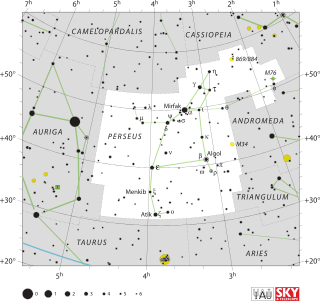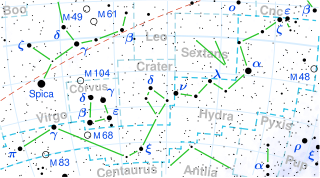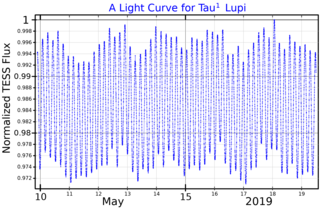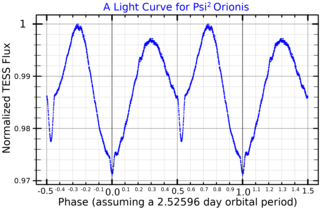Beta Cephei variables, also known as Beta Canis Majoris stars, are variable stars that exhibit small rapid variations in their brightness due to pulsations of the stars' surfaces, thought due to the unusual properties of iron at temperatures of 200,000 K in their interiors. These stars are usually hot blue-white stars of spectral class B and should not be confused with Cepheid variables, which are named after Delta Cephei and are luminous supergiant stars.

Omicron Velorum is a star in the constellation Vela. It is the brightest member of the loose naked eye open cluster IC 2391, also known as the ο Velorum Cluster.

Iota Canis Majoris, Latinized from ι Canis Majoris, is a solitary variable supergiant star in the southern constellation of Canis Major. It is visible to the naked eye with an apparent visual magnitude that varies between +4.36 and +4.40. The distance to this star is approximately 2,500 light years based on spectroscopic measurements. It is drifting further away with a radial velocity of +42 km/s.

27 Canis Majoris is a binary star system in the northern constellation of Canis Major, located approximately 1,700 light years away from the Sun. It has the variable star designation EW Canis Majoris; 27 Canis Majoris is the Flamsteed designation. This system is visible to the naked eye as a dim, blue-white hued star with an apparent visual magnitude of +4.65. It is moving away from the Earth with a heliocentric radial velocity of 16 km/s.

Chi Carinae, Latinised from χ Carinae, is a star in the southern constellation of Carina. It is a third-magnitude star and is one of the brighter members of the constellation. The distance to the star can be determined directly through parallax measurements, yielding an estimate of roughly 450 light-years with a 6.7% margin of error. This star is a suspected astrometric binary, although nothing is known about the companion.

V343 Carinae is a blue-white star or star system in the southern constellation of Carina. It has the Bayer designation d Carinae, while V343 Carinae is a variable star designation. The star is visible to the naked eye with an apparent visual magnitude of 4.31. The distance to this object is approximately 1,440 light years based on parallax. It is drifting further away with a radial velocity of +13 km/s.

Epsilon Persei, Latinized from ε Persei, is a multiple star system in the northern constellation of Perseus. It has a combined apparent visual magnitude of +2.88, which is bright enough to be viewed with the naked eye. Based upon parallax measurements, this system is located at a distance of roughly 640 light-years (196 parsecs) from Earth.

λ Crucis, Latinized as Lambda Crucis, is a single, variable star in the southern constellation Crux, near the constellation border with Centaurus. It is visible to the naked eye as a faint, blue-white hued point of light with an apparent visual magnitude that fluctuates around 4.62. The star is located approximately 384 light-years distant from the Sun based on parallax, and is drifting further away with a radial velocity of +12 km/s. It is a proper motion member of the Lower Centaurus–Crux sub-group in the Scorpius–Centaurus OB association, the nearest such association of co-moving massive stars to the Sun.

Alpha Muscae, Latinized from α Muscae, is a star in the southern circumpolar constellation of Musca. With an apparent visual magnitude of +2.7, it is the brightest star in the constellation. The distance to this star has been determined using parallax measurements, giving an estimate of about 315 light-years from Earth.

9 Cephei, also known as V337 Cephei, is a variable star in the constellation Cepheus.

Eta Hydrae is a star in the equatorial constellation of Hydra. With an apparent visual magnitude of 4.3, it is visible to the naked eye. However, it is the faintest of the five stars that form the "head" of the hydra. Based upon an annual parallax shift of 5.56 mas, it is located roughly 590 light years from the Sun.

Tau1 Lupi, Latinized from τ1 Lupi, is a solitary star in the southern constellation of Lupus. It is visible to the naked eye with an apparent visual magnitude of 4.5. Based upon an annual parallax shift of only 2.99 mas as seen from Earth, it is located about 1,090 light years from the Sun. Tau1 Lupi may be a runaway star having a peculiar velocity of 32.6±3.6 km/s. It is a member of the Upper Centaurus–Lupus sub-group of the nearby Sco OB2 association.

19 Monocerotis is a single, variable star in the equatorial constellation of Monoceros, located approximately 1,220 light years away from the Sun based on parallax. It has the variable star designation V637 Monocerotis, while 19 Monocerotis is the Flamsteed designation. This object is visible to the naked eye as a faint, blue-white hued star with a baseline apparent visual magnitude of 5.00. It is receding from the Earth with a heliocentric radial velocity of +25 km/s.

QZ Puppis is a class B2.5V star in the constellation Puppis. Its apparent magnitude is 4.5 and it is approximately 650 light years away based on parallax.

HD 54893, often called A Puppis is a suspected variable star in the constellation Puppis. Its apparent magnitude is 4.83 and is approximately 860 light years away based on parallax.

N Scorpii, also known as HD 148703, is a solitary, bluish-white hued star located in the southern constellation Scorpius. It has an apparent magnitude of 4.23, making it readily visible to the naked eye. N Scorpii was initially given the Bayer designation Alpha Normae by Lacaille but it was later moved from Norma to Scorpius. N Scorpii is currently located 550 light years away based on parallax measurements from the Hipparcos satellite and is part of the Upper Scorpius–Centaurus region of the Scorpius–Centaurus association.

BW Vulpeculae or BW Vul, is a variable star in the northern constellation of Vulpecula. It is near the lower limit of visibility to the naked eye with a typical apparent visual magnitude of 6.54. Based on an annual parallax shift of 1.15 mas, the distance to BW Vul is about 2,800 light years. It is moving closer to the Earth with a baseline heliocentric radial velocity of around −6 km/s.

FN Canis Majoris is a binary star system in the southern constellation Canis Major, near the northern constellation border with Monoceros. It is dimly visible to the naked eye with a combined apparent visual magnitude of 5.41. The system is located at a distance of approximately 3,000 light years from the Sun based on parallax, and is drifting further away with a radial velocity of +31 km/s. It is a runaway star associated with the Sh 2-296 nebula in the CMa OB1 association, and has a conspicuous bow-shock feature.

NW Puppis, also known as υ2 Puppis, is a star in the constellation Puppis. Located around 910 light-years distant, it shines with a luminosity approximately 1,108 times that of the Sun and has a surface temperature of 15,000 K.

Psi2 Orionis a binary star system in the equatorial constellation of Orion. It has an apparent visual magnitude of 4.6, indicating that it is visible to the naked eye. Based upon an annual parallax shift of 2.87 mass, it is roughly 1,100 light years distant from the Sun.


















